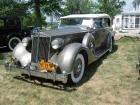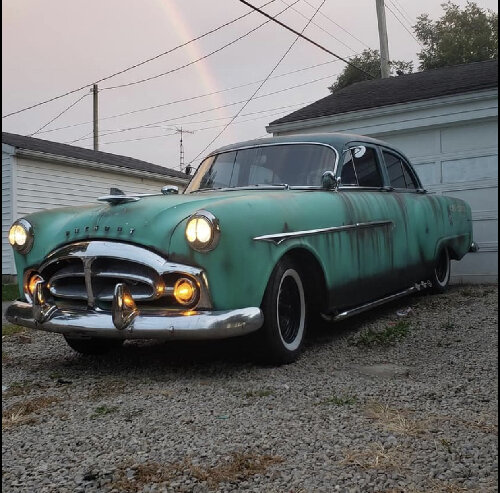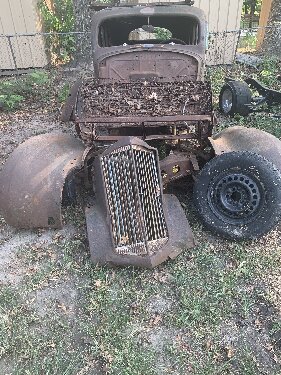|
Re: 54 Packard ignition switch / cylinder head temp gauge
|
||||
|---|---|---|---|---|
|
Home away from home
|
Summit racing markets a number of mechanical temperature sensors, those might work, and then you wouldn't have to mess with any wiring. They are also cheaper and more reliable.
Summit Racing Mechanical Water Temperature gauge
Posted on: 2023/4/15 14:41
|
|||
|
||||
|
Re: 1941 Packard 160
|
||||
|---|---|---|---|---|
|
Home away from home
|
A couple of things:
1) You don't actually fill the radiator to the top. You fill it so the water (cold) is just covering the radiator core. The expansion volume is actually the top of the radiator volume. So it's not uncommon, the first time you drive it for a while after you fill up the radiator, for it to "spit out" some. 2) I might re-check your timing and check your spark plugs and spark plug wires, both at the spark plug and at the coil. I remember the first time I went for a long drive one of my spark plug wires wasn't attached, though it looked like it. The connector needed to be crimped a little so it would hold on better.
Posted on: 2023/4/13 16:59
|
|||
|
||||
|
Re: Need 1941-47 Clipper rear transmission snubber grommets
|
||||
|---|---|---|---|---|
|
Home away from home
|
McMaster let's you buy in relatively small quantities now.
Here's one that might work(?) box of 10 is $11.25 McMaster-Carr grommet, 9/16" hole diameter
Posted on: 2023/4/13 14:35
|
|||
|
||||
|
Re: When I hit the pedal it cuts the power on my 1949 22 series
|
||||
|---|---|---|---|---|
|
Home away from home
|
you can connect a wire direct from a pushbutton 50-amp switch under the dash to the solenoid. You can disconnect the carb starter and just use that. Or you can keep the carb starter if it proves to be good, and have both. Sometimes it's useful to have the pushbutton switch even when the carb starter switch is working.
Posted on: 2023/4/11 9:22
|
|||
|
||||
|
Re: 1954 Cavalier Ball joints
|
||||
|---|---|---|---|---|
|
Home away from home
|
The Kanter website is a little confusing unless you know where to go. Here is the page that lists all the 1948-1954 parts. Just scroll down from there:
Kanter Packard Parts 1948-1954
Posted on: 2023/4/8 22:44
|
|||
|
||||
|
Re: HELP! car dies when hot.
|
||||
|---|---|---|---|---|
|
Home away from home
|
Good that the gasket etc. is the same. Probably the pump stroke is ok.
What I was suggesting was hook up a vacuum gage to the input of the pump. That will tell you how much vacuum the pump can pull. It's a simple test. I don't know offhand how much that should be, others could tell you. One not insignificant possibility is one of the check valves got some crud in it and isn't closing properly, and hence you aren't getting enough pump suction. If its not that, and the glass filter isn't obstructed, the only other thing I can think of is an obstructed fuel line from the tank.
Posted on: 2023/4/5 22:42
|
|||
|
||||
|
Re: HELP! car dies when hot.
|
||||
|---|---|---|---|---|
|
Home away from home
|
Well, three things:
1) atmospheric pressure is 14.7 psi. That's the most the pump can "pull" if the entire system was beyond perfect, but in the real world it cannot even do that. See what comes out at 10 psi, because the pump won't be able to pull a super-strong vacuum, and 10 psi is probably about what it can effectively pull. That might help determine if there is an obstruction. If you can simply use a vacuum pump or vacuum gage on the line itself, that would be a good test. 2) You could simply plug the pump into a vaccuum gage (instead of the bucket) and see what it's doing. That would tell you whether there is a seal or check-valve in the pump that is bad. Could be you sucked up some crap into one of the check valves and it isn't working effectively. One reason I have one of those cheapy see-through in-line fuel filters before the pump, though I know everyone hates those. 3) The starter doesn't crank the engine very fast, but still, could be a bad pump. 4) I know you were putting the pump on where it hadn't been installed in a long time. If for some reason you installed the pump "too far away", e.g. with too thick a gasket or a plate or something else, the effective stroke of the pump will be reduced, and therefore it's effective pumping power. It should still be able to pull a vacuum but it won't be able to pump very much fluid volume, and it will take a long time to pump up to it's maximum vacuum.
Posted on: 2023/4/5 21:26
|
|||
|
||||
|
Re: 1950 327 Water Pump Bolts
|
||||
|---|---|---|---|---|
|
Home away from home
|
IIRC, it's pretty self-explanatory as to which bolt goes where, the pump itself has holes at different heights.
I remember the copper washers are for the bolts that go into holes which are open to the water jacket. I thought I only remembered two, the other ones just had lockwashers. IIRC you can get those at a good hardware store, they are pretty generic. But partly I am responding to bump this to the top for someone else to weigh in.
Posted on: 2023/4/1 10:05
|
|||
|
||||
|
Re: 288 Head Gasket Planning
|
||||
|---|---|---|---|---|
|
Home away from home
|
you want to make sure the head and the mating surface is very clean, especially around the studs.
If you have to let it sit for a day or even a week until the next weekend, I just sprayed the head down with WD-40 and covered it with an old towel and closed the hood. Of course if you are worried about mice or something maybe you have to do more. Check the studs to make sure they aren't loose, and if they are, make sure to use some thread sealant, especially for those go into the cooling channels in the block. There is a nice tool for stud removal that you can get rather inexpensively from Autozone or Amazon. There are discussions about this in the forum. Make sure you check the torque after each heat/cool cycle for the first 3 or 4 cycles, until everything settles down. Seems to be important.
Posted on: 2023/3/31 11:41
|
|||
|
||||








